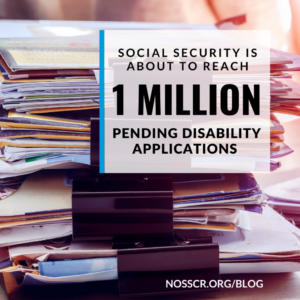We’re Fast Approaching One Million People Awaiting Decisions
We are heading towards a dismal threshold; at the state agencies the Social Security Administration (SSA) contracts with for initial-level medical determinations and the first level of appeals (called reconsideration), there will soon be over a million cases awaiting decisions.
At the end of December 2021, there were 971,426 pending cases: 776,660 initial claims and 194,766 reconsiderations, according to SSA data (which is broken down by state and territory). This is a 9.4% increase over December 2020 and 27.6% higher than the number of claims pending in December 2019.
There are many reasons for this increase, but a high number of applications is not among them. In fact, disability claims have been decreasing for over a decade, and the decline has steepened during the pandemic. According to SSA data, fewer Social Security Disability Insurance (SSDI) disabled worker claims were filed in 2021 than in any year since at least 2006. Data on Supplemental Security Income (SSI) claims show a 17% decrease in child SSI applications and a 13% decrease in applications for people aged 18-64 from 2019 to 2020 (the most recent information available).
The National Association of Disability Examiners (NADE) reported that the national average processing time last year was 165 days for initial claims and 147 days for reconsiderations. In Fiscal Years 2015-2019, the average processing time ranged from 110-120 days for initial claims and 101-113 days for reconsiderations.
More people waiting for disability decisions, and longer waits for the decisions, are taking a toll on individuals, families, and communities. In some situations, eligibility for SSI or SSDI allows an uninsured person to obtain Medicaid or Medicare, so delays in processing disability claims can cause people to delay medical treatment, or leave hospitals and clinics to provide more uncompensated care.
Additional administrative funds for SSA could improve the situation. The House passed an appropriations package that would increase funding, but it hasn’t become law; the federal government is operating on a continuing resolution that freezes SSA’s funding at last year’s level. SSA could also resume the policy it had during the first months of the pandemic when state agencies were directed to focus on initial and reconsideration decisions instead of Continuing Disability Reviews (CDRs), which determine if current beneficiaries have medically improved and no longer qualify for disability benefits.
While there are a number of ways to change course, it requires action. We hope to be able to share a swift resolution soon.
Share!
Follow us
Recent posts
NOSSCR Interim CEO Speaks on SSA Overpayments on Good Morning Arizona
Our interim CEO, David Camp, recently appeared on Good Morning Arizona to address the problem of Social Security’s clawbacks of benefit payments. Recipients face additional stresses and unneeded burdens. Modernization at the Social Security Administration...
New leadership is a reason for optimism in 2024
On December 20, 2023, Martin J. O’Malley was sworn in as Commissioner of Social Security. He will serve until January 19, 2025. After more than two years of leadership uncertainty and instability at SSA, O’Malley’s...
Spotlight on SSA’s budget: NYT and 60 Minutes
The budget crisis at SSA continues to hurt the most vulnerable among us, with administrative delays, redundancies, and overpayment clawbacks that put the onus on beneficiaries to correct the agency’s errors. Public pressure is building...



